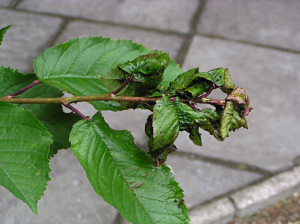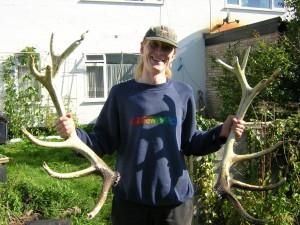I have written before about aphids and how their quest for the ideal food plant may explain the evolution of host alternation; we find that most aphid species tend to be associated with rapidly growing meristems, or newly flushing leaves (Dixon, 2005). Some aphids are so keen on young plant tissue that they ‘engineer’ youth in their host plants, injecting salivary compounds and forming leaf–rolls, pseudo-galls and galls, all of which act as nutrient sinks and lengthen the time that the modified leaves stay green and nutrient-rich
Leaf-roll caused by Rhopalosiphum padi on bird cherry, Prunus padus.
Pronounced leaf roll pseudo-gall caused by Myzus cerasi on Prunus avium.
Non host-alternating (autoecious) aphids, such as the sycamore aphid Drepanosiphum platanoidis, the maple aphid, Periphyllus testudinaceus, or the birch aphid, Euceraphis punctipennis, have no such escape route; they are confined to their tree host for the year, albeit, they can, if they ‘wish’, fly to another tree of the same species, but essentially they are held hostage by the their host plant. As the season progresses, leaf nutritional and physical properties change; going from young tender green leaves, with high nitrogen and water contents, to mature, tough leaves, low in nitrogen and water to yellow senescing leaves with again, higher nitrogen levels (Awmack & Leather, 2002) and finally of course, dead brown leaves of no nutritional value.
Sycamore and maple aphids, enter a state of suspended animation ‘summer aestivation’ (Essig, 1952; Dixon, 1963), whilst birch and poplar aphids, whose hosts plants often produce new growth during the year, ‘track’ these new leaves (Wratten, 1974; Gould et al., 2007). As far as these aphids are concerned young tissue is their best food source, with senescent tissue being second best and mature leaves being least favoured. During the summer they will, however, take advantage of mature leaves that are prematurely senescing, such as those attacked by leaf diseases such as tar spot. I have often found sycamore aphids feeding and reproducing on these infected leaves whilst those aphids on neighbouring mature leaves remain in aestivation.
Effects of tar spot on sycamore leaves
Host-alternating (heteroecious) aphids on the other hand are somewhat different. As their life cycle includes a programmed migration back to their primary tree host in autumn, those autumn morphs (oviparae) are adapted to senescent tissue (Leather & Dixon, 1982, Kundu & Dixon, 1993, 1994). Similarly, the spring morphs (fundatrices and fundatrigeniae) are adapted to young leaves and find it difficult or impossible, to make a living on senescent leaves.

There are yet other aphids, such as the green spruce aphid Elatobium abietinum, the pine aphid, Eulachnus agilis and the black pecan aphid, Melanocallis caryaefoliae, that are senescence specialists. In contrast to the flush specialists, these aphids engineer senescence, also using salivary compounds, and are unable to survive on young foliage (Bliss, 1973; Fisher, 1987; Cottrell et al., 2009).
Elatobium abietinum ‘engineering’ senescence on spruce needles and avoiding young flushing tissue.
It is interesting to speculate that perhaps these tree-dwelling non host-alternating aphids are secondarily derived from the autumn part of the life-cycle of host-alternating aphids. After all, if non host-alternating aphids on herbaceous host plants are off-shoots of the summer part of the host-alternating life-cycle why not the other way round. There is just so much more to learn about aphids. Yet another reason why I love aphids so much 😉
References
Awmack, C.S. & Leather, S.R. (2002) Host plant quality and fecundity in herbivorous insects. Annual Review of Entomology, 47, 817-844.
Bliss, M., Yendol, W.G., & Kearby, W.H. (1973) Probing behaviour of Eulachnus agilis and injury to Scotch pine. Journal of Economic Entomology, 66, 651-655.
Cottrell, T.E., Wood, B.W. & Ni, X. (2009) Chlorotic feeding injury by the Black Pecan Aphid (Hemiptera: Aphididae) to pecan foliage promotes aphid settling and nymphal development. Environmental Entomology, 38, 411-416.
Dixon, A.F.G. (1963) Reproductive activity of the sycamore aphid, Drepanosiphum platanoides (Schr) (Hemiptera, Aphididae). Journal of Animal Ecology, 32, 33-48.
Dixon, A.F.G. (2005) Insect Herbivore-Host Dynamics. Cambridge University Press, Cambridge.
Fisher, M. (1987) The effect of previously infested spruce needles on the growth of the green spruce aphid, Elatobium abietinum. Annals of Applied Biology, 111, 33-41.
Gould, G.G., Jones, C.G., Rifleman, P., Perez, A., & Coelman, J.S. (2007) Variation in Eastern cottonwood (Populus deltoides Bartr.) phloem sap content caused by leaf development may affect feeding site selection behaviour of the aphid, Chaitophorous populicola Thomas (Homoptera: Aphididae). Environmental Entomology, 36, 1212-1225.
Kundu, R. & Dixon, A.F.G. (1993) Do host alternating aphids know which plant they are on? Ecological Entomology, 18, 61-66.
Kundu, R. & Dixon, A.F.G. (1994) Feeding on their primary host by return migrants of the host alternating aphid, Cavariella aegopodii. Ecological Entomology, 19, 83-86.
Leather, S.R. & Dixon, A.F.G. (1981) Growth, survival and reproduction of the bird-cherry aphid, Rhopalosiphum padi, on it’s primary host. Annals of applied Biology, 99, 115-118.
Wratten, S.D. (1974) Aggregation in the birch aphid, Euceraphis punctipennis (Zett.) in relation to food quality. Journal of Animal Ecology, 43, 191-198.
Post script
A lot of what I describe comes from a talk I gave in 2009 at a workshop in Oxford on autumn colours (the output of which was Archetti, M., Döring, T.F., Hagen, S.B., Hughes, N.M., Leather, S.R., Lee, D.W., Lev-Yadun, S., Manetas, Y., Ougham, H.J., Schaberg, P.G., & Thomas, H. (2009) Unravelling the evolution of autumn colours: an interdisciplinary approach. Trends in Ecology & Evolution, 24, 166-173. I always meant to write the talk up as an Opinion piece but procrastination set in badly. I was somewhat annoyed with myself when earlier this year this excellent piece by the legendary ecologist and entomologist, Tom White, appeared; I have only myself to blame, six years is a very long bit of procrastination 😉
White, T.C.R. (2015) Senescence-feeders: a new trophic sub-guild of insect herbivores Journal of Applied Entomology, 139, 11-22.
Post post script
This post is dedicated to my eldest son, Sam, who died quietly in his sleep, at a tragically young age, December 23rd 2010. It would have been his birthday on the 21st May. Despite being a molecular biologist, (he worked at the Sanger Institute), he was as green as you can get, a great naturalist and conservationist, with an incredibly gentle soul. He strongly believed in conserving the World’s natural resources and amused colleagues by sticking up signs in the toilets at the Sanger, which read “If its yellow let it mellow, if its brown flush it down”.
He is sorely missed by us all. He also had more Nature papers than me 😉
Parkhill, J., Achtman, M., James, K.D. et al., (2000) Complete DNA sequence of a serogroup A strain of Neisseria meningitides. Nature, 404, 502-506
Parkhill, J., Dougan, G. , James, K.D. (2001) Complete genome sequence of a multiple drug resistant Salmonella enterica serovar Typhi CT18. Nature, 413, 848-852.
Parkhill, J., Wren, B.W., Thomson, N.R. et al., (2001) Genome sequence of Yersinia pestis, the causative agent of plague. Nature, 413, 523-527.
Parkhill, J., Sebaihia, M., Preston, A. et al., (2003) Comparative analysis of the genome sequences of Bordetella pertussis, Bordetella parapertussis and Bordetella bronchiseptica. Nature Genetics, 35, 32-40
Wood, V., Gwilliam, R. Rajandream, M.A. et al., (2002) The genome sequence of Schizosaccharomyces pombe . Nature, 415, 871-880







So sorry to hear about Sam, it must be one of the more difficult times of the year. Amelia
LikeLiked by 1 person
thank you – yes indeed, you never get over it, you just learn to live with it
LikeLike
Pingback: Morsels For The Mind – 29/05/2015 › Six Incredible Things Before Breakfast
So sorry to hear about Sam, he sounded wonderful and you’ve written a wonderful tribute to him in this post. Emma
LikeLike
Thank you – May and Christmas are always difficult times, Simon
LikeLiked by 1 person
My thoughts to you and your family.
LikeLiked by 1 person
Pingback: Not all aphids get eaten – “bottom-up” wins this time | Don't Forget the Roundabouts
Pingback: British Ecological Society Annual Meeting 2018 – representing ecologists but not ecology? | Don't Forget the Roundabouts
Pingback: Green Islands – mining cytokinins | Don't Forget the Roundabouts